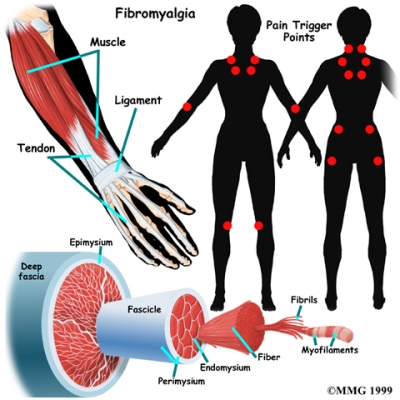After osteoarthritis, the most common musculoskeletal disease is fibromyalgia. But despite the number of people afflicted with this condition—around 12 million people in the United States have it—fibromyalgia is largely misunderstood. This could be attributed to its similarity with osteoarthritis and other conditions like tendinitis and bursitis.
The difference is that the pain caused by the two conditions are limited to a specific area of the body, pain and stiffness caused by fibromyalgia are endemic. Women aged 25 to 60 years old are the most common sufferers of this condition. It is said that women are 10 times more likely to be afflicted with fibromyalgia than men.
Symptoms
 Pain is the most common symptom of this condition. People who are afflicted with fibromyalgia will experience ache all over their body. They will also notice that there are specific parts of their body that are tender and painful to touch. People who have fibromyalgia describe the pain felt in the muscles as like having been pulled or overworked. The muscle throbbing will also feel like being twitched or burned. The pain can also occur around the joints in the shoulder, neck, back and hips.
Pain is the most common symptom of this condition. People who are afflicted with fibromyalgia will experience ache all over their body. They will also notice that there are specific parts of their body that are tender and painful to touch. People who have fibromyalgia describe the pain felt in the muscles as like having been pulled or overworked. The muscle throbbing will also feel like being twitched or burned. The pain can also occur around the joints in the shoulder, neck, back and hips.
Thus patients will find it impossible to exercise and even sleep. In fact, it is a common occurrence for them to be awaken during deep slumber because of the discomfort caused by the condition. Sufferers feel depressed as a result. Other common symptoms of this ailment are abdominal pain, chronic headache, hypersensitivity to cold and heat, inability to focus, dryness in the eyes, nose and mouth, and incontinence. Some sufferers also complain of irritable bowel syndrome and tingling sensation in the fingers and feet. It should be noted that most of these symptoms are very similar to the symptoms of osteoarthritis, tendinitis and bursitis which explains why fibromyalgia is usually misdiagnosed as one of these conditions.
Diagnosis
FM/a is the blood test conducted to diagnose fibromyalgia. Doctors will also need a comprehensive physical exam and medical history to make the right diagnosis. Other tests like complete blood count and tests for chemicals may also be required. Some doctors also ask their patients to undergo a thyroid test since hypothyroidism or an underactive thyroid can have the same symptoms like fibromyalgia such as depression, muscle pain and weakness.
Treatment
There are many drugs prescribed for fibromyalgia like Cymbalta or duloxetine HCI, an antidepressant. The recommended dosage for treatment of the said condition is 60 mg taken once or twice daily. Cymbalta was approved as a drug for management of fibromyalgia in June 2008. It was originally for treatment of depression and generalized anxiety disorder. It is not clear how Cymbalta helps relieve pain associated with fibromyalgia.
Some scientists say that the drug works by increasing the levels of two substances — serotonin and norepinephrine — that are found in the brain and other areas of the nervous system. These substances can affect mood and influence feelings of pain. When Cymbalta is able to prevent the substances from re-entering the cells, the levels of these substances increase in the body and thus pain is lessened among patients suffering from fibromyalgia.
Share This